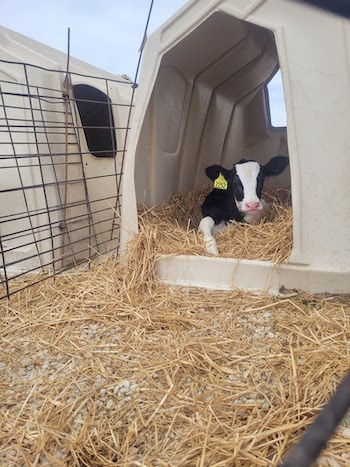
I took a walk out to our calf hutches last week to begin summer preparations to that area of our farm. While it’s still cool in dairy areas in the Northern United States, we have already seen our first day over 90°F.
We raise our calves in individual hutches with wire-fenced outdoor pens, and we provide milk, grain, and water via buckets. During the winter, the calves are bedded down with straw and the hutches’ back windows are wired closed to keep the cold, north wind off their backs.
In the summer, we switch to bedding with pine shavings and open those rear hutch doors to promote ventilation and cooling. Those were the two tasks I tackled last week as the thermometer ticked upward.
My final preparation for summer will come as we remind feeders of what to watch out for in terms of disease and especially dehydration during the summer. In the type of weather that we see in the summer, mild dehydration can get out of hand quickly.
Here are a few tips from Iowa State University’s Jennifer Bentley for evaluating and addressing dehydration.
“A calf with diarrhea but no other clinical signs and a strong suckling reflex could be 5% to 6% dehydrated,” she shared in an online extension publication. “Calves showing mild depression, weakness, and sunken eyes but still sucking is 6% to 8% dehydrated. A calf that will not stand and has cool extremities is in serious condition with a dehydration level of 10% to 14%.”
On our operation, calves receive electrolytes as soon as diarrhea is identified during the summer. If a calf cannot stand, our veterinarian administers intravenous (IV) fluids, but we always try to catch cases before they reach this point.
Bentley recommends the pinch test for identifying level of dehydration. Here are her benchmarks:
- Normal hydration: skin flattens in 2 seconds
- 8% dehydration: skin flattens in 2 to 6 seconds
- Over 10% dehydration: skin takes more than 6 seconds to flatten
Finally, Bentley warns that summer temperatures may demand greater levels of electrolyte assistance.
“When temperatures are over 90°F, increase the amount of electrolytes fed by 50%. If temperatures are over 100°F, double the amount,” she advised. “To determine the amount of electrolytes to feed, multiply the weight of the calf by the percent dehydration, and then divide by 2 to get quarts of liquid needed.”
Ready or not, summer is on the way. Prepare your calf raising area for the warm temperatures to come and review these guidelines to help your calves stay hydrated and healthy.

The author is a dairy farmer in Kansas and a former associate editor at Hoard’s Dairyman. Raised on a 150-cow dairy near Valley Center, Kansas, Maggie graduated from Kansas State University with degrees in agricultural communications and animal sciences.








